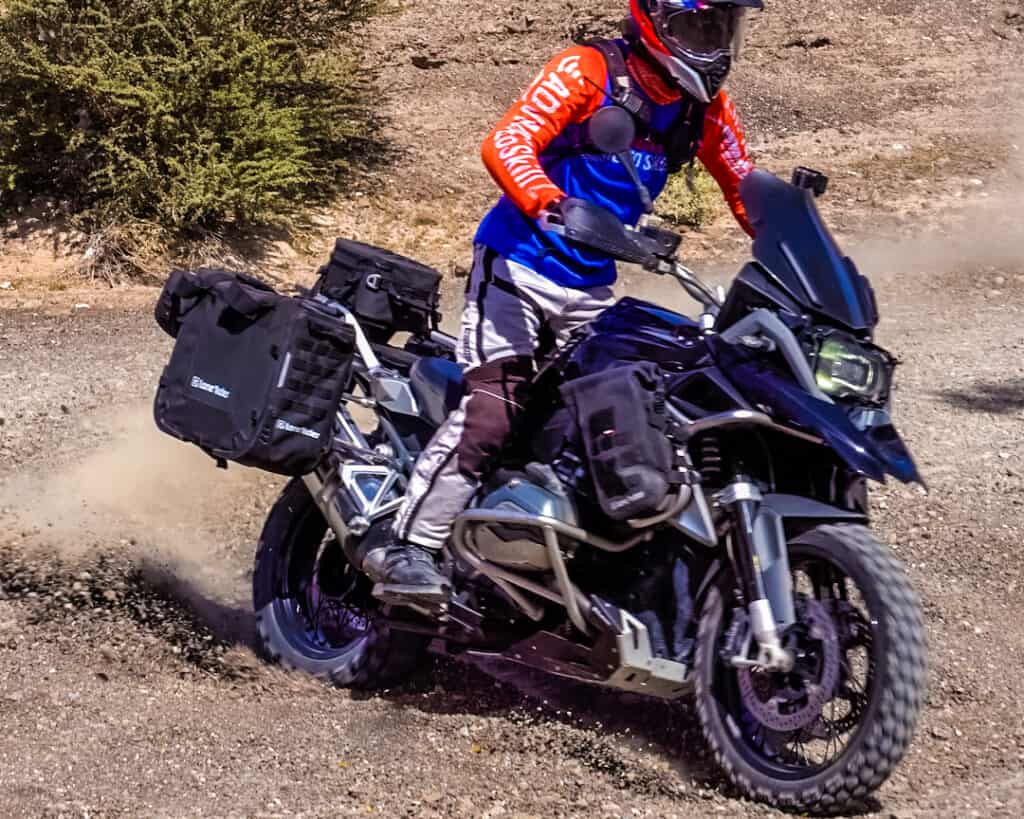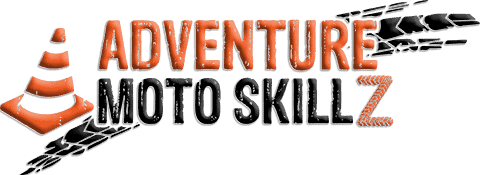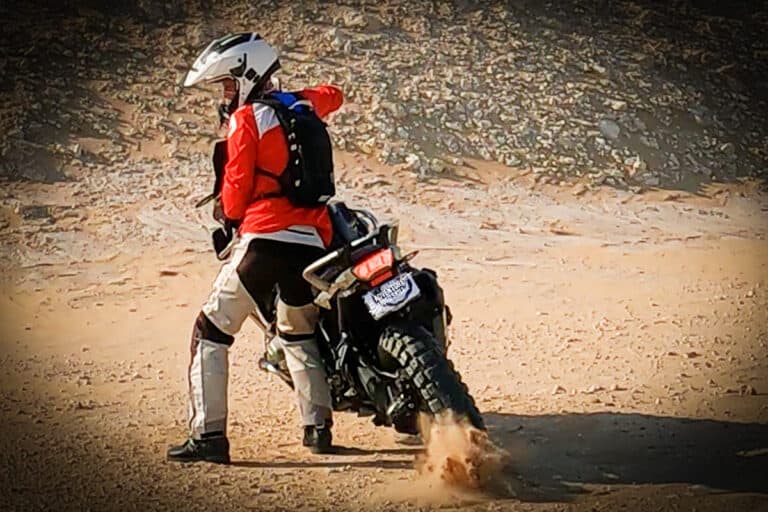Keeping Balance on an Off-Road Motorcycle – Beginner Tips
If you’re new to off-road motorcycle riding, then it’s important to know the basics of how to stay balanced on your bike. Unlike on a street bike, you’ll need to use different techniques to stay upright when riding off-road. In this post, we’ll discuss some tips for beginner riders that will help them keep their balance and have a more enjoyable experience out on the trails.
Beginner off-road riders can master good motorcycle balance skills by first learning the bike’s tipping point on level ground and then progressing to use body posture to control the bike on uneven surfaces for optimal balance. Balance drills can start at home and then expand to off-road practice.
This post may contain Affiliate Links. Please see our Privacy & Disclosure Policy for more details.

The practice drills reviewed in this post can start right in your driveway or garage to build confidence and foundational skills. Just create a safe open space around your bike and practice can begin. Remember – All The Gear All The Time – even when practicing at home or with the bike powered off. Let’s start!

Top-quality gear for your next adventure
Used and recommended by ADVMotoSkillZ
How can a beginner rider learn to balance a motorcycle?
The motorcycle’s balance point is the spot where the bike can stay upright on its own. To learn the balance point of your motorcycle, let’s try the following drills:
Note: these can be practiced in a controlled environment such as your backyard, driveway, or garage. It is possible that you will drop the bike during these drills, so be sure the practice surface and the area surrounding the bike are safe for the bike to land.
Balance Drill #1 – Walk Around The Bike
- With the bike engine off, stand on the left side and lift up the side stand while holding the bike with both hands
- Slowly, walk around the bike while continuing to move your hand positions to keep the bike upright
- Do not move positions until you are confident the bike is balanced
- Once you complete a full 360 walk around the bike, put the side stand down
Balance Drill #2 – Seated Balance
- Sit on the motorcycle with the engine off
- Lift up the side stand and place your right foot on the right peg
- Now bring the left foot up to the left peg and try to balance
- As the balance is lost, just touch the ground with one foot and try again
- Attempt to keep balance with both feet on the pegs for more time on each attempt
TIP: When first practicing these balance drills, reduce tire pressure down to 1 bar/14psi to increase contact patch of tire to ground (this will be easier than at full pressure)

Innovative Motorcycle Tool Sets – Compact & Reliable
Used and recommended by ADVMotoSkillZ
Balance Drill #3 – Standing Balance
- Sit on the motorcycle with the engine off
- Lift up the side stand and place your right foot on the right peg
- Now stand up while bringing the left foot up to the left peg
- As the balance is lost, return to a seated position with both feet on the ground and try again
- Attempt to keep balance standing with both feet on the pegs for more time on each attempt
These balance drills will teach you when and how rider input is required so the bike remains balanced and upright. This understanding will pay off ten-fold out on the trail when the terrain is constantly creating off-balance scenarios for the bike.
What should be done if the bike is going to fall during these drills?
Learning proper bike rescue is just as important as learning how to stay upright. Here are a few tips:
- When practicing balance drills, such as Walk Around the Bike, be prepared to use your body to stabilize the bike as needed
- If the bike starts to tip towards you, shift your body towards the bike and allow the outside of your hip to “catch” the bike and support it
- Do not try to recover a falling bike with only arms and upper body as this can lead to arm and back injuries
- If the bike is falling away from you, grab the bike firmly with both hands and counterbalance the bike by dropping into a squat position
Active balance practice for off-road motorcycling
Now that you have grasped the concept of balance and how to keep the motorcycle upright on even surfaces, it’s time to move on to active balance. Active balance is the act of using your body weight to control the motorcycle while underway. This is a more advanced motorcycle skill that takes time and practice to master, but once you have it down, you’ll be able to navigate just about any off-road terrain with ease.
Here are some tips for practicing active balance:
Start on level ground – As you become more comfortable with the motorcycle’s balance point, you can begin practicing on uneven surfaces.
Use your body weight – Learning to use your body weight is key to active balance. As the motorcycle leans, you’ll need to adjust your weight accordingly to keep the motorcycle upright.
Look where you want to go – When riding off-road, it’s important to always look ahead at where you want to go. This will help you navigate around obstacles and keep the motorcycle balanced.
This video shows off-road balance practice on even-level ground. Perform this in a location that offers 50-100 meters/yards of driving space without obstacles or hazards. Start with the beginner moves only until you build skill and confidence.
A few other exercises ideas to help learn active balance are:
Agility Course – Set up an agility course in an available open space and practice maneuvering the motorcycle around cones or obstacles. This will help you learn how to use your body weight to control the motorcycle.
This video highlights the use of an agility course to fine tune balance/counterbalance techniques and how that knowledge can be used when off-road.
Slow speed riding practice – Riding the bike in 1st gear (slowly) requires top balance skills. The faster the bike travels, the more stable it becomes. ADV riding frequently demands slow and deliberate riding to safely cross technical terrain.
Whoops – Another great way to practice active balance is to find a set of whoops (mounds of dirt that are close together) and ride through them. This will help you learn how to use your body weight to control the motorcycle as it goes up and down over the whoops.
Once you’ve mastered the basics of balance, you’ll be well on your way to becoming a skilled off-road rider. Just remember to always practice safety first and never ride beyond your skill level.
Body position basics to master balance on your bike off-road
As a motorcycle rider, you know that body position is important. But when you’re riding off-road, body position becomes even more critical. That’s because when you’re riding off-road, you’re constantly dealing with uneven surfaces, obstacles, and other challenges that can throw your motorcycle off balance.
That’s why it’s so important to learn how to control your motorcycle with your body. With the right body position, you can keep your motorcycle balanced and navigate any off-road terrain.
Here are some tips for mastering body position on your motorcycle off-road:
- Use standing posture in technical off-road sections
- Have solid foot placement on pegs
- Squeeze tank or narrow part of seat with knees/lower legs
- Transfer body weight by shifting hips front to back and side to side
- Stay light on the handle bars
- Look ahead to where you want to go
Coupling good balance skills with smooth control inputs (throttle-clutch-brake balance) will then raise your riding to the next level. Let’s take a look here:
Learning how to control your motorcycle’s balance on uneven surfaces will make you a better rider when off-road. Begin by practicing at home on level ground and then move on to uneven surfaces. Remember to use your body posture to help keep the bike upright. Be patient, it may take some time to get the hang of it, but eventually, you’ll be able to ride with ease over any terrain. Ready to give it a try? Practice these balance drills today!

About the Author
Coach Mike is a Certified Off-Road Motorcycle Instructor & founder of ADVMotoSkillZ.
Riding tips from ADVMotoSkillZ reach thousands of international riders daily through social & blogs.
Click here to learn more about Mike’s motorcycle evolution from a Harley road rider to finding his true passion for off-road riding on a BMW 1200 GS.
If you would like to send Mike a quick message or invite him to provide training at your local facility, then visit the contact page here.






